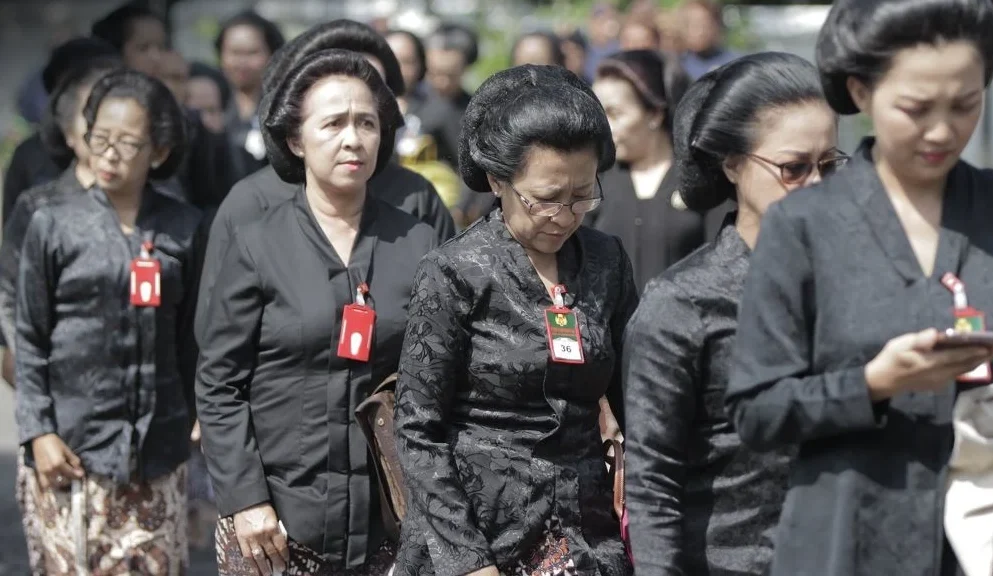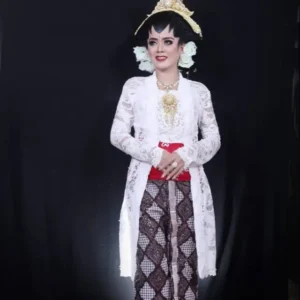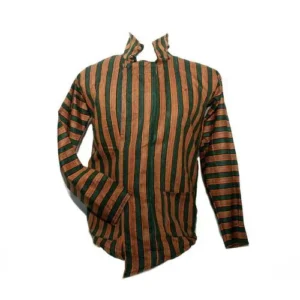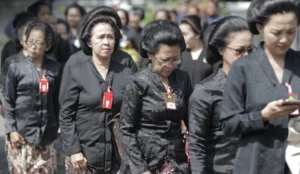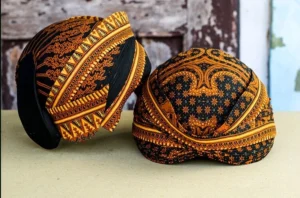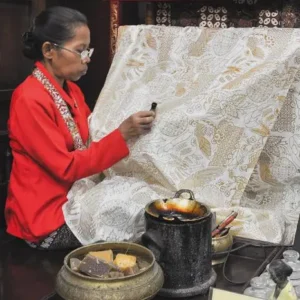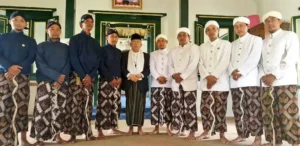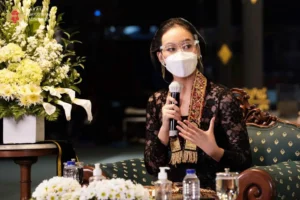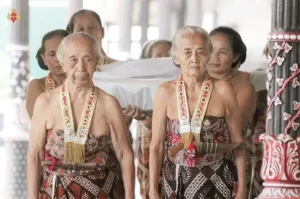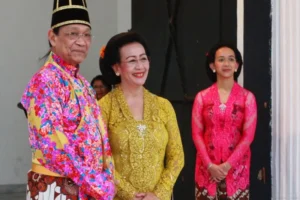Yogyakarta, a city on the island of Java rich in culture and traditions, houses the beauty and elegance of its renowned traditional clothing. Whenever Yogyakarta is mentioned, one cannot overlook the charm contained within its traditional garments. In every fold of fabric and ornament, deep cultural and historical values are integrated, signifying the uniqueness and richness of Indonesian cultural heritage.
From the seductive kebaya with its elegance to the blangkon emanating masculinity, each element of Traditional Outfits of Yogyakarta has its own captivating story. Through colors, patterns, and crafting techniques, traditional clothing becomes a reflection of the grandeur and beauty of local traditions.
Not only as formal attire, but Traditional Outfits of Yogyakarta are also symbols of identity and pride for its inhabitants. During every traditional ceremony, festival, or celebration, traditional clothing always draws attention, captivating the hearts of people worldwide.
With its wealth of traditional clothing, Yogyakarta not only attracts attention as a cultural tourist destination but also strengthens and preserves a precious cultural heritage for future generations. By preserving and appreciating the existence of its traditional clothing, Yogyakarta continues to celebrate the diversity and splendor of Indonesian culture.
Understanding Traditional Outfits of Yogyakarta
Traditional Outfits of Yogyakarta are an integral part of Indonesia’s fascinating cultural richness. Known for their elegant beauty and distinctive uniqueness, Traditional Outfits of Yogyakarta symbolize pride for the local population and serve as an attraction for tourists eager to explore the beauty of Indonesian culture.
Understanding Traditional Outfits of Yogyakarta means delving into a rich and diverse cultural heritage. Each element of Traditional Outfits of Yogyakarta carries deep meaning symbolizing local wisdom and traditional values still highly respected today. A striking example is the diversity of colors and patterns on these garments. Vibrant colors such as yellow, green, red, and blue often dominate Traditional Outfits of Yogyakarta, reflecting joy and lively life.
Traditional Outfits of Yogyakarta are not just garments but also reflections of history, beliefs, and cultural identity of its community. The form, color, and patterns of each traditional outfit carry symbolic messages passed down through generations.
Furthermore, Traditional Outfits of Yogyakarta are often worn during various traditional ceremonies and events such as weddings, artistic performances, and cultural festivals. Their enduring presence in various cultural celebrations demonstrates the importance of Traditional Outfits of Yogyakarta as an indispensable element of local community life.
The uniqueness of Traditional Outfits of Yogyakarta also attracts travelers eager to discover the beauty and richness of Indonesian culture. Cultural tours highlighting Traditional Outfits of Yogyakarta are often a prime destination for tourists seeking to experience authentic traditional atmosphere.
By learning more about Traditional Outfits of Yogyakarta, we can better appreciate and understand Indonesian cultural diversity. Moreover, by promoting and preserving Traditional Outfits of Yogyakarta, we also contribute to the preservation of a precious cultural heritage for future generations. Thus, Traditional Outfits of Yogyakarta are not just inanimate objects but also guardians of noble values that continue to live and evolve in the lives of Yogyakarta’s population and Indonesia as a whole.
11 Traditional Outfits of Yogyakarta
1. Kebaya Yogyakarta
source : jurnalismeinvestigatif.com
Traditional Outfits of Yogyakarta are stunningly beautiful, and one of the most famous is the Kebaya. The Kebaya Yogyakarta is not only a symbol of elegance but also represents cultural richness and diversity. Paired with batik, the Kebaya Yogyakarta creates astonishing harmony between tradition and modern style. The fine details and elegant design of this Kebaya not only attract attention but also bring their own charm to every occasion, especially formal events and weddings in Yogyakarta.
It is not surprising that the Kebaya Yogyakarta is the top choice for many individuals due to its unparalleled luxury. The beauty and splendor of this Kebaya evoke the elegance and pride of Yogyakarta’s rich cultural heritage. Whether in traditional ceremonies or modern events, the Kebaya Yogyakarta remains at the center of attention and solidifies its position as a symbol of strong cultural identity.
On many occasions, the Kebaya Adat Yogyakarta is chosen as the perfect representation of precious local culture. The elegance and grace of the Kebaya Yogyakarta bring their own charm to every appearance. With undeniable beauty, the Kebaya Yogyakarta strengthens the rich cultural identity and greatly contributes to the cultural wealth of Yogyakarta, which deserves to be recognized.
2. Surjan
source : paseban-jati.blogspot.com
Traditional Outfits of Yogyakarta play an important role in the cultural life of its people. An example is the Surjan, a traditional attire for men originating from Yogyakarta. The Surjan is made from high-quality materials and is often adorned with characteristic traditional patterns. Elegance and masculinity are two inseparable traits of the Surjan, making it the primary choice for men for various traditional events and even weddings.
Commonly used materials for making the Surjan include batik and songket. Batik brings a marked traditional touch, while songket adds an impression of luxury and exclusivity to the Surjan. These two materials are carefully chosen to ensure the quality and beauty of each piece of Surjan produced. The traditional patterns often present on the Surjan also have deep meaning and philosophy, reflecting the cultural richness and values of Yogyakarta society.
By combining the beauty of these patterns with modern design, the Surjan remains relevant in the evolving times. Thus, the Surjan is not simply a traditional attire of Yogyakarta but also a symbol of identity and pride for its people. Its continued preservation and respect highlight the importance of preserving cultural heritage for future generations.
3. Janggan Hitam
source : jogja.idntimes.com
Traditional Outfits of Yogyakarta not only provide beauty for women but also for men with their majestic Janggan Hitam. The Janggan Hitam is the primary choice for formal events in Yogyakarta, emanating elegance and masculinity in every detail. The complex crafting technique of the Janggan Hitam produces high-quality works, reflecting the finesse and elegance of Javanese culture.
Paired with traditional accessories such as blangkon and keris, the Janggan Hitam is not just a garment but also a symbol of pride and dignity. A man wearing the Janggan Hitam will exude a noble and classy appearance, suggesting the inherent strength and courage of Yogyakarta tradition. At every occasion, this traditional attire leaves a profound impression, reflecting cultural richness and ancestral heritage.
As an essential element of Yogyakarta culture, the Janggan Hitam is not just a garment but a precious heritage that must be preserved and protected. By wearing the Janggan Hitam, men from Yogyakarta strengthen their cultural identity, making traditional clothing a symbol of unity and pride for their ancestors’ legacy.
4. Blangkon
source: gotravelly.com
The Blangkon is one of the most respected traditional headgears in Yogyakarta. Made from fabrics with characteristic patterns, the Blangkon is not just an accessory but also an inseparable part of Traditional Outfits of Yogyakarta. Men in Yogyakarta proudly wear it as a symbol of their identity and cultural pride. During every traditional event, the Blangkon is always the preferred choice to complement their attire.
Its presence brings a magical touch that connects the past to the present, thereby reinforcing the richness and value of the culture. The Blangkon is not limited to being just a headgear; it also reflects the beauty of local art. The carefully chosen patterns reflect the richness of Yogyakarta’s cultural heritage. When paired with other traditional garments, the Blangkon is not just an additional accessory but a prominent element that enhances the beauty and elegance of traditional attire.
By maintaining the use of the Blangkon in traditional clothing, the people of Yogyakarta ensure that their cultural heritage remains alive and continues to thrive. Each time a Blangkon is worn, it is not just a garment but also a statement of identity and love for tradition. Its enduring presence in Traditional Outfits of Yogyakarta is evidence of the strength and perseverance of a culture that has survived through the ages.
5. Batik Yogyakarta
source: theindonesiaadventure.com
Batik is one of Indonesia’s invaluable cultural treasures, and Yogyakarta plays a crucial role as one of the top centers of batik production in Indonesia. The characteristic patterns of Yogyakarta’s batik are often inspired by the beauty of nature and local mythology, creating captivating artworks that enchant batik enthusiasts.
On various occasions, whether for everyday wear or traditional attire, Yogyakarta’s batik remains a fitting choice to display the beauty and pride of local culture. The uniqueness and beauty of batik patterns serve not only to adorn appearance but also to reflect the cultural richness of Yogyakarta. Paired with other traditional garments, such as the Blangkon, Yogyakarta’s batik adds an extraordinary touch to the traditional look.
Its presence goes beyond complementing garments but also reinforces the identity and pride of the cultural heritage passed down through generations. Thus, Yogyakarta’s batik is not just a fabric but also a symbol of the beauty, richness, and continuity of Indonesian culture, especially in the context of Yogyakarta’s culture.
6. Pinjung
In the context of Traditional Outfits of Yogyakarta, Pinjung is a fabric that plays an important role as a shawl or head covering for women. Made from high-quality materials and often adorned with magnificent embroideries, Pinjung is not just an accessory but also a statement about the elegance and beauty of Traditional Outfits of Yogyakarta.
On every occasion, Pinjung adds an elegant and graceful touch to the appearance of women who wear it. Paired with a kebaya and batik, Pinjung becomes an essential element of Traditional Outfits of Yogyakarta. Its presence is not only about embellishing appearance but also about reinforcing the identity and pride of the local culture.
Not only as an additional accessory, Pinjung has deep meaning in the context of Traditional Outfits of Yogyakarta. Every fold and pattern on Pinjung reflects the richness of the cultural heritage held by Yogyakarta society. Thus, the use of Pinjung is not just about style but also about the preservation and respect of traditions and cultural values passed down through generations. In this context, Pinjung is not just a part of the garment but also a part of the identity and pride of Yogyakarta’s inhabitants in preserving their traditional culture.
7. Busana Pranakan
source: uraianlengkap.blogspot.com
Busana Pranakan is the result of a fascinating blend between Chinese and Javanese cultures, creating a unique and colorful garment. Rich patterns and delicate details are distinctive features of each Busana Pranakan. Often worn at weddings and cultural festivals, this attire serves not only to embellish appearance but also to represent harmony between two different cultures.
The beauty of Busana Pranakan lies not only in its visual aesthetics but also in the cultural significance it holds. By wearing Busana Pranakan, the society of Yogyakarta expresses the richness of the region’s cultural diversity. Every fold of fabric and carefully chosen motif reflects cherished traditional values.
As a symbol of Yogyakarta’s rich cultural diversity, Busana Pranakan plays a crucial role in preserving and celebrating the existing cultural heritage. With each appearance, this garment not only represents visual beauty but also reminds of the importance of preserving and appreciating cultural diversity as an essential element of Yogyakarta society’s identity. Thus, Busana Pranakan is not just clothing but also a manifestation of pride in the cultural heritage passed down through generations.
8. Sabukwala
source: mamikos.com
Sabukwala is one of the indispensable clothing accessories in Traditional Outfits of Yogyakarta, especially for men. Made from high-quality materials such as leather or finely woven fabric, Sabukwala serves not only to complement appearance but also to symbolize luxury and elegance.
The uniqueness of Sabukwala lies in the gold or silver ornaments that often adorn certain parts. These ornaments add a touch of luxury and elegance to each outfit, making Sabukwala an attractive and remarkable accessory. Paired with a surjan or janggan, Sabukwala immediately adds a graceful and elegant impression to Traditional Outfits of Yogyakarta.
In the context of Traditional Outfits of Yogyakarta, Sabukwala is not just an additional accessory but also an important part of presenting the elegance and beauty of traditional clothing. Its careful and meticulous use reflects respect for traditions and cultural heritage that have existed for centuries. Thus, Sabukwala is not just a part of clothing but also a part of the identity and pride of local culture, rich in values and traditions.
9. Semekan
source: arsnewsy.com
Semekan is one of the essential elements of Traditional Outfits of Yogyakarta, especially as a shawl or head covering for women. This long fabric is made from high-quality materials such as silk or cotton, woven with delicate details. Additionally, Semekan is often adorned with beautiful embroideries, adding elegance and beauty to every outfit.
The uniqueness of Semekan lies in its ability to instantly add a touch of elegance and grace. Paired with a kebaya and batik, Semekan becomes an indispensable accessory of Traditional Outfits of Yogyakarta. Its careful and thoughtful use not only adds aesthetic value but also is an important part of presenting the beauty of traditional clothing.
At every occasion, Semekan plays a role not only as a complement to attire but also as a symbol of the beauty and pride of local culture. Its distinctive and characteristic use in Traditional Outfits of Yogyakarta is tangible evidence of the richness and diversity of traditions held by Yogyakarta society. Thus, Semekan is not just an accessory but also an integral part of the identity and culture of Yogyakarta.
10. Kencongan
source: student-activity.binus.ac.id
Kencongan is one of the indispensable clothing accessories of Traditional Outfits of Yogyakarta, especially for women’s wear. Made from high-quality materials such as silk or soft fabrics, Kencongan is often adorned with beautiful decorations like beads, sequins, or intricate embroideries. The beauty of its ornaments not only adds a touch of elegance and class to every outfit but also brings the characteristic luxury of Traditional Outfits of Yogyakarta. In harmony with the kebaya and pinjung, Kencongan becomes one of the main accessories of Traditional Outfits of Yogyakarta.
Its careful and meticulously chosen use not only demonstrates love for tradition but also manifests the beauty and elegance of traditional costume. Kencongan is not just an additional accessory but an integral part of women’s appearance in Traditional Outfits of Yogyakarta. On every occasion, Kencongan becomes a symbol of the beauty and elegance of the local culture, bringing a striking beauty that captivates anyone who sees it.
Thus, the use of Kencongan is not just about style but also about the preservation and respect of traditions and cultural values passed down through generations. In this context, Kencongan becomes an inseparable element of the identity and pride of Traditional Outfits of Yogyakarta.
11. Busana Ageng
source: pakaianstylish.blogspot.com
Busana Ageng is the epitome of luxury and elegance in Traditional Outfits of Yogyakarta, especially worn by the royal family of Yogyakarta. Made from high-quality materials such as fine silk or characteristic traditional fabrics, Busana Ageng is always adorned with luxurious and impressive decorations.
Every detail is carefully designed, not only to adorn appearance but also to reflect the status and high dignity of the royal family. The use of Busana Ageng is incomplete without the association with traditional accessories such as Blangkon for men and gold jewelry for women. This combination creates an appearance that not only impresses but also captivates the heart of everyone who sees it.
As an integral part of a rich culture, Busana Ageng becomes a symbol of the luxury and elegance of Yogyakarta’s culture. From graceful kebaya to luxurious Busana Ageng, Traditional Outfits of Yogyakarta offers a variety of options to charm with elegance. Each element of this traditional costume is not only a garment but also carries a history and profound meaning, reflecting the cultural richness and unique traditions of Yogyakarta.
Through the harmony between tradition and modernity, Traditional Outfits of Yogyakarta continues to charm and inspire new generations to preserve and appreciate this precious cultural heritage. Thus, Traditional Outfits of Yogyakarta is not just a part of appearance but also a mirror of the identity and pride of this cultural heritage passed down from generation to generation.
Read also: The 11 Amazing Traditional Dances of Yogyakarta
Conclusion
With its diversity and cultural richness, Yogyakarta has seen its traditional clothing not only as a part of its history but also as an essential element in shaping its identity and community pride. In its diversity, from kebayas combined with batik fabrics to the ageng attire worn by the royal family, every piece of traditional clothing offers a rich representation of Yogyakarta’s beauty, elegance, and cultural wealth.
The combination of kebaya with batik reflects the harmony between Javanese and Chinese culture, while ageng attire showcases the grandeur and dignity of the royal family. Every detail, from design to ornaments, is carefully crafted to enhance the beauty and elegance of Traditional Outfits of Yogyakarta.
The use of Traditional Outfits of Yogyakarta is not just about appearance but also an expression of cultural identity passed down from generation to generation. By wearing them, the community of Yogyakarta strengthens its connection with tradition and maintains the cultural diversity that characterizes this region.
Thus, Traditional Outfits of Yogyakarta is not just garments but also symbols of pride and cultural identity. Their presence reminds us of the importance of preserving precious cultural heritage and symbolizes the beauty and grandeur of Yogyakarta’s tradition, which has evolved over the centuries.
In your quest for the beauty of Traditional Outfits of Yogyakarta, you will be taken on an adventure that delves deeper into the culture and history of this city. Every detail of the traditional clothing will make you feel the richness of the meanings they contain, and how each piece of clothing is an indispensable element of the identity and pride of the Yogyakarta community.

